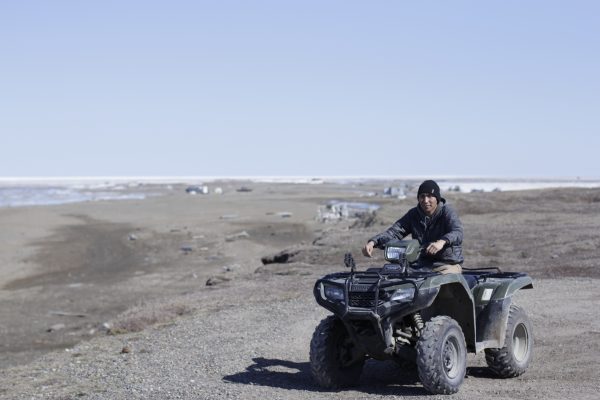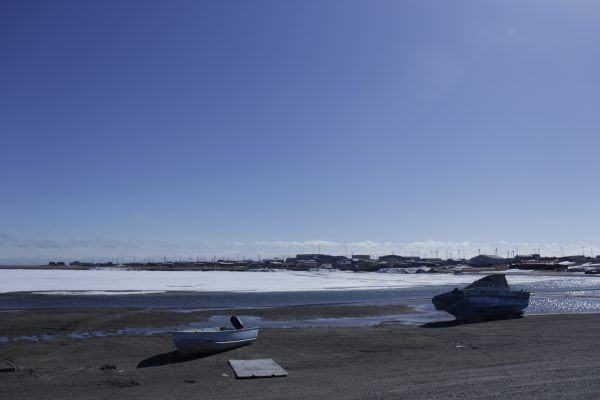
The Trump administration will soon take a big step toward drilling for oil in the Arctic National Wildlife Refuge. It hopes to sell leases to companies before the end of the year.
It’s a major reversal, after Congress opened up the refuge a year and a half ago. For decades, opponents argued that drilling will harm the refuge’s unique landscape, and its caribou and birds. But many of the Alaska Native residents of Kaktovik, the only community inside the refuge, see oil development as an opportunity — though others remain deeply skeptical.
Even into June, a mile-long shelf of ice hemmed in the village of 250, which sits on an island in the Arctic Ocean on Alaska’s northeast coast.
But Arctic sea ice has been melting, and that means more hungry polar bears have been coming to Kaktovik. On a recent warm spring day, Nathan Gordon Jr., 24, kept watch from the seat of his four-wheeler. He is part of the village’s polar bear patrol.
“It’s part of my job to make sure the town is safe, and all the visitors and the polar bears at the same time,” he said.
The Arctic Refuge’s tundra and mountains surround Kaktovik — there are no roads in or out, and there’s no oil infrastructure nearby.
But Gordon’s paycheck comes largely from the oil industry, thanks to drilling in Prudhoe Bay to the west. The industry pays some $370 million in annual property taxes to the North Slope Borough, and that money, in addition to Gordon’s salary, helped build Kaktovik’s $16 million new basketball gym. It also funds a full-time fire department, with two gleaming fire trucks.
Residents also have flush toilets, which are lacking in dozens of other villages outside the refuge. Oil, Gordon said, has done a lot for Kaktovik and its Native Inupiat residents, and he supports drilling in the refuge.

“People have been benefiting really great through all of this,” he said. “Opening ANWR — it would be great for our kids, for the economy, for our village and everything that would go on.”
Kaktovik is surrounded by the refuge’s coastal plain — the area that Congress opened to development. Indigenous opposition to drilling is centered in Gwich’in communities, more than 100 miles away from the refuge’s coastal plain.
In interviews, Kaktovik’s drilling boosters said they’re frustrated with what they see as a tendency by outsiders to defer to the views of the Gwich’in people, even though the Inupiat have lived on the North Slope for thousands of years.
“They try and just blatantly tell us: ‘No, you cannot do this on your own land. We have more of a right to what you do in your own community, in your own village,’” said Charles Lampe, 43, a Kaktovik whaling captain who supports development. “They think that we’re trying to make it to where it’s just going to be a big oil field out there. That’s not what we’re trying to do.”
Kaktovik’s drilling backers say they want to make sure that development doesn’t jeopardize residents’ ability to harvest both caribou and whale.
The average Kaktovik household consumes hundreds of pounds of caribou each year, and as much as 1,000 pounds of bowhead whale, according to surveys. When it comes to caribou, Gordon said he doesn’t expect them to harmed by oil infrastructure.
“I wouldn’t be worried about it at all,” he said. “It’ll be a lot safer for them to be out there than being hunted by me.”
If development does harm the Porcupine caribou herd, whale meat would be a safety net for the residents of coastal Kaktovik that’s lacking in landlocked Arctic Village. But Lampe, the whaling captain, rejected the idea that Arctic Village is more dependent on caribou.

“If they wanted whale, we’d send them whale,” Lampe said. “I mean, that’s the kind of community and the kind of people we are.”
Other Kaktovik residents are less convinced that oil infrastructure can coexist with their traditions. A poll of 93 people conducted by the village government found 52 percent in favor of development, 32 percent oppose it and the rest are unsure.
Carla Kayotuk, an avid hunter and camper who opposes drilling, said that even living in a small village, she values the open spaces nearby.
“When we get away, it’s quiet right now. And I’m afraid, once the development starts happening, that’s not going to happen,” she said. “Where are we going to go?”
Speaking up against development can be intimidating here, Kayotuk said. She’s been accused of ignoring benefits from oil that could come to the village, she said.
“We’re not ignorant,” she said. “We just value something different than what you value.”
It’s still too early to know exactly how close oil infrastructure might come to Kaktovik. After a lease sale, companies will still have to drill wells to see if commercially viable amounts of oil even exist under the coastal plain. If they find it, they’ll need environmental reviews and permitting before they can pump it out.
From atop the bluff at the edge of town, Gordon, the polar bear patroller, looked out over the tundra to the west, where he thinks the first development is likely. What does he think he’ll see on the horizon once development starts?
“Nothing,” he said. “You won’t be able to see a footprint out there.”
It will take years to see if Gordon’s prediction comes true.




